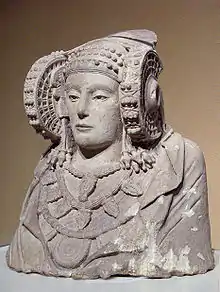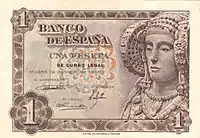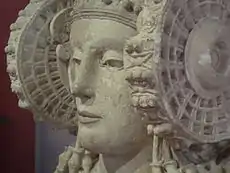Lady of Elche
The Lady of Elche (in Spanish, Dama de Elche in Valencian, Dama d'Elx) is a limestone[1] bust that was discovered in 1897, at La Alcudia, an archaeological site on a private estate two kilometers south of Elche, Spain. It is now exhibited in the National Archaeological Museum of Spain in Madrid.
| Lady of Elche | |
|---|---|
| Dama de Elche | |
 | |
| Type | Bust |
| Material | Limestone |
| Height | 56 cm (22 in) |
| Width | 45 cm (18 in) |
| Depth | 37 cm (15 in) |
| Weight | 65.08 kg (143.5 lb) |
| Discovered | 1897 La Alcudia, Elche |
| Discovered by | Manuel Campello Esclápez |
| Place | National Archaeological Museum |
| Culture | Iberians |
It is generally known as an Iberian artifact from the 4th century BC, although the artisanship suggests strong Hellenistic influences.[2] According to The Encyclopedia of Religion, the Lady of Elche is believed to have a direct association with Tanit, the goddess of Carthage, who was worshiped by the Punic-Iberians.[3]
Sculpture
The bust, originally colored represents a woman wearing an elaborate headdress and large wheel-like coils (known as rodetes) on each side of the face.[4] The opening in the rear of the sculpture indicates it may have been used as a funerary urn.[5]
Other artifacts associated with Iberian culture are the Lady of Guardamar—which has similar wheel-like rodetes and necklaces―or the Lady of Baza. While the Lady of Elche is a bust, there are indications that it was part of a seated statue, similar to the Lady of Baza (with which it shares similar necklace pendants) or a standing one like the Gran Dama Oferente from Cerro de los Santos (Montealegre del Castillo, Albacete).
These three figures and the Bicha of Balazote are exhibited in the same Iberian art hall in the National Archaeological Museum of Spain in Madrid.
Discovery and repatriation

The sculpture was found on 4 August 1897, by a young worker, Manuel Campello Esclapez. The popular version of the story differs from the official report by Pere Ibarra (the local keeper of the records) which stated that Antonio Maciá found the bust. Ibarra's version of the discovery story, was that farm workers clearing the southeast slope of La Alcudia for agricultural purposes, discovered the sculpture. The bust was quickly nicknamed "Reina Mora" or "Moorish Queen" by locals.[1]
An archaeological site is now located where the bust of Elche was discovered. Evidence has been found there of an Iberian-Punic settlement, a Roman sewer, walls and Roman houses, and mosaics. One mosaic shows an effigy of Saint Abdon, belonging to a Christian basilica of the 5th century. The latter archaeological evidence is supported by the codices of the councils of Toledo where it discusses an audience with bishops from Illici (Elche).
Dr. Campello, owner of the farm, was married to Asunción Ibarra, daughter of Aureliano Ibarra Manzoni, a 19th century humanist and amateur archeologist. Ibarra Manzoni had found a number of objects and Iberian vestiges on his own farmland and in other places in the municipality of Elche. He built up a valuable collection, which he bequeathed to his daughter Asunción. He provided instructions that she make the necessary arrangements for the collection to be offered for sale to the Real Academia de la Historia after her death, to be located finally at the National Archaeological Museum. The will specified that the collection be sold in its entirety. The family placed the Lady on their balcony so that it could be viewed by all of the residents of Elche.[1]
Don Pedro Ibarra invited French archaeologist Pierre Paris to his home to see the Mystery Play of Elche. When the archaeologist saw the Iberian bust, he recognized its worth and notified the Louvre in Paris. The Louvre offered a large sum of money for the time: 4000 francs, and purchased the sculpture within a few weeks of its discovery. Despite opposition from Doña Asuncion, the Iberian bust was sold. On 30 August 1897, the sculpture was sent to the Louvre.

For 40 years the Dama de Elche was exhibited at the Louvre. After the start of World War II in 1939, as a precaution, the sculpture was transferred for safe-keeping to the castle of Montauban near Toulouse.[1] The Vichy government negotiated the statue's return to Spain with Franco's government. In 1941 it was returned through an exchange of works (which also included the Immaculate Conception of the Venerable Ones (or Immaculate Conception of Soult) by Murillo, the twin sphinxes of El Salobral and several pieces of the Treasure of Guarrazar, and the Iberian sculptures of Osuna. In return Spain transferred to France a portrait of Mariana of Austria by Velázquez (the Prado kept another existing version of the portrait, which was considered of superior quality)[1] and a Portrait of Antonio de Covarrubias by El Greco.[6] Since 1941, the Lady of Elche has been officially owned by the Museo del Prado (catalog number E433).
The discovery of the Lady of Elche initiated a popular interest in pre-Roman Iberian culture. She appeared on a 1948 Spanish one-peseta banknote and was mentioned in William Gaddis's The Recognitions (1955).
In 1971 it was transferred from the Prado to the National Archaeological Museum of Spain,[7] where it is currently exhibited.

Exhibitions in Elche
In 1965 the Dama de Elche returned briefly to Elche, on the occasion of the seventh centenary of Mystery Play of Elche.
On 19 January 2006, the Minister of Culture of Spain, Carmen Calvo, issued a decision to temporarily lease the Lady to its hometown. From 18 May 2006, to 1 November 2006. the Dama de Elche presided over the inauguration of the Museum of Archaeology and History of Elche (in the Palace of Altamira) and the exhibition From Ilici to Elx, 2500 Years of History that took place in different locations in the city. It was represented by an exact replica afterwards.[8][9]
Contentions of forgery
The bust was first accused of being a forgery in 1906, in an essay called Las esculturas del Cerro de los Santos, cuestión de autenticidad by archeologist José Ramón Mélida.



In 1995, art historian John F. Moffitt (1940-2008),[10] published Art Forgery: The Case of the Lady of Elche (University Press of Florida) in which he contended that the statue was a forgery, citing its stylistic differences from ancient Iberian prototypes.[11] Moffitt suggested that the sculpture could be the work of well-known forger Francisco Pallas y Puig (1859-1926), commissioned by the landowner, Manuel Campello Antón (1833-1904)[12] to coincide with a visit from French archaeologist Pierre Paris, who purchased the sculpture for the Louvre.[13][14] Moffitt discussed the sculpture in the context of a "golden age" of forgery[15] in the nineteenth and early twentieth century, which followed a growing cultural interest in collecting art and artifacts.[11][16]
Experts in Spanish archaeology have rejected Moffitt's theory and accept the Lady of Elche as a genuine ancient Iberian work. Antonio Uriarte of the University of Madrid has stated: "Decade by decade, research has reinforced the coherence of the Lady within the corpus of Iberian sculpture. The Lady was found more than a century ago, and many of its features, not then understood, have been confirmed by subsequent finds. For example, the use of paint in Iberian sculpture was unknown when the Lady appeared."[17] A Consejo Superior de Investigaciones Científicas (CSIC) study on the Lady of Elche's micropigmentation published in 2005 concluded that the trace pigments on the statue were consistent with ancient materials and that no modern pigments had been found.[18]
Throughout the 20th century, other similar iberian busts will be discovered in the southwest of Spain, such as the Lady of Baza, the Lady of Caudete, the Lady of Guardamar or the Lady of Cerro de los Santos.
In 2011, María Pilar de Luxán,[19] the author of the 2005 study, analyzed microparticles within the back hole of the Dama de Elche utilizing electron microscopy and X-ray dispersive spectrometry. Luxán deduced that the particles belonged to the ashes of human bones and that they compared with those of the Iberian period. She concluded that the statue was used as a funerary urn in the Iberian period, thus guaranteeing its antiquity and confirming the hypothesis about its function.
In 2017, Sonia Gutiérrez Llore, chair of the Department of Archaeology at the University of Alicante and director of the University's Institute of Investigation in Archaeology and Historical Heritage-INAPH,[20] wrote about the many discrepancies in the narrative surrounding the sculpture's origin as it evolved into idealized, national symbol.[21] "A story has been built around the Lady that has avoided the obvious uncertainties, if not true contradictions," Gutiérrez Llore said, "but that by dint of being transmitted to future generations has ended up becoming the dominant historical memory, considered truthful, traditional and unquestionable."[22]
In modern culture
The Lady of Elche stands as a statue representing Phoenicia as one of the Seafaring Nations at the Alexander Hamilton Custom House facade.
French artist James Tissot based figures in several of his turn-of-the-century paintings on the Lady of Elche.[23]

Dama de Elche was depicted on the 1948 1 Peseta banknote.
The Dama de Elche makes an appearance in Part III of William Gaddis's 1955 novel The Recognitions, when the character Wyatt Gwyon examines a one peseta note and calls the engraving of the bust a "beautiful thing".[24]
A large prominent sculpture "La Dama Ibérica"[25] based on The Dama de Elche and created by the Spanish sculptor Manolo Valdés in 2007 overlooks a major intersection in the downtown region of Valencia, Spain.
In the 2022 Marvel Cinematic Universe film Thor: Love and Thunder, the Lady of Elche appears as one of the gods invited to Omnipotence City, played by Nicole Milinkovic.[26]
References
- M.A. (4 August 2016). "Misterios sin aclarar de la Dama de Elche" [Unresolved mysteries of the Lady of Elche]. ABC (in Spanish). Madrid.
- Vives Boix, Francisco (2000). La Dama de Elche en el año 2000: análisis tecnológico y artístico [The Lady of Elche in 2000: Technological and artistic analysis]. Gorgona (in Spanish). Vol. 8. Valencia, Spain: Ediciones Tilde. ISBN 978-84-95314-91-8.
- Jones, Lindsay, ed. (2005). "Iberian Religion". Encyclopedia of Religion. Vol. 6 (2nd ed.). Detroit, MI: Macmillan Reference. p. 549. ISBN 002865739X. LCCN 2004017052.
- Simons, Marlise (23 January 1997). "A Beloved Lady of Spain, Hostage in a Tug-of-War". The New York Times. ISSN 0362-4331. Retrieved 30 September 2022.
- "Dama de Elche". www.man.es (in Spanish). Retrieved 30 September 2022.
- "Cronología del museo". 1941. Enciclopedia del Museo del Prado (in Spanish). Asociación Amigos del Museo del Prado. Archived from the original on 24 December 2014. Retrieved 28 April 2009.
- Elvira Barba, Miguel Ángel. "Dama de Elche [anónimo]" [Lady of Elche [anonymous]]. Enciclopedia del Museo del Prado (in Spanish). Fundación de Amigos del Museo del Prado.
- "Facsimile of the Dama de Elche". FactumArte. Retrieved 14 November 2014.
- "Museo Arqueológico y de Historia de Elche (MAHE)". VisitElche. Retrieved 1 November 2014.
- "Dr. John Francis Moffitt Obituary (1940 - 2008) Las Cruces Sun-News". Legacy.com. Retrieved 13 June 2022.
- "Art forgery : the case of the Lady of Elche / John F. Moffitt". Smithsonian Institution. Retrieved 13 June 2022.
- Alonso, Francisco Gracia (2021). Ciencia y política: la organización de la arqueología y la prehistoria en España, 1850-1939 (in Spanish). Edicions Universitat Barcelona. p. 88. ISBN 978-84-9168-192-2.
- Vitelli, Karen D. (1 October 1995). "Art Forgery: The Case of the Lady of Elche. By John F. Moffitt". American Journal of Archaeology. 99 (4): 755. doi:10.2307/506215. ISSN 0002-9114. JSTOR 506215.
- Grummond, Nancy Thomson de (11 May 2015). Encyclopedia of the History of Classical Archaeology. Routledge. ISBN 978-1-134-26861-0.
- Briefel, Aviva (2006). The Deceivers: Art Forgery and Identity in the Nineteenth Century. Cornell University Press. pp. 1–18. ISBN 978-0-8014-4460-9.
- Swenson, Astrid (2020), "Under False Pretenses", Time Travelers, University of Chicago Press, doi:10.7208/chicago/9780226676821.001.0001, ISBN 978-0-226-67665-4, S2CID 203367217, retrieved 13 June 2022
- Olmos Romera, Ricardo; Tortosa Rocamora, Trinidad (1999). "Appendix to S. Aguilar's article". In Tsetskhladze, Gocha R. (ed.). Ancient Greeks West and East. Mnemosyne, Supplements. Vol. 196. Brill. pp. 352–360. ISBN 978-90-04-35125-7.
- Tamar Hodos (March 2000). "Ancient Greeks West and East". Bryn Mawr Classical Review (Review).
- de Luxán Gómez del Campillo, Mª Pilar; Prada Pérez, José Luis; Dorrego Rodríguez, Fernando (April 2005). "Dama de Elche: Pigments, surface coating and stone of the sculpture". Materials and Structures. RILEM. 38 (277): 419–424. doi:10.1007/BF02479310. ISSN 1359-5997. S2CID 136622739.
- Luxán, M. P.; Prada, J. L.; Dorrego, F (2011). "Human bone ashes found in the Dama de Elche (V–IV century B.C.) reveal its use as an ancient cinerary urn". Journal of Cultural Heritage. 12 (3): 310–316. doi:10.1016/j.culher.2010.12.006.
- "Sonia Gutiérrez Lloret. Department of Prehistory, Archaeology, Ancient History, Greek and Latin". dprha.ua.es. Retrieved 13 June 2022.
- Lloret, Sonia Gutiérrez (1 January 2017). "GUTIÉRREZ LLORET, S., Memorias de una Dama. La Dama de Elche como "lugar de Memoria"". Moreno Martín, Francisco J. (Ed.). El franquismo y la apropiación del pasado. El uso de la historia, de la arqueología y de la historia del arte para la legitimación de la dictadura. Madrid: Editorial Pablo Iglesias, 2017. ISBN 978-84-95886-76-7, pp. 67-92.
- Olaya, Vicente G. (30 August 2019). "El misterio del hombre que encontró la Dama de Elche". El País (in Spanish). ISSN 1134-6582. Retrieved 13 June 2022.
- Landers, Solomon (August 1991). "Did Jephthah Kill His Daughter?". Bible Review. Vol. 7, no. 4. Biblical Archaeology Society.
Tissot modeled her exotic headgear, including two ear-wheels, on a famous bust, the Lady of Elche, found in Elche, Spain, in 1897. Archaeologists of the day cited Near Eastern parallels for some of the bust's characteristics and called the style Greco-Phoenician, leading Tissot to assume that the headgear represented a typical fashion for biblical women.
- Gaddis, William (1985) [1955]. The Recognitions. Penguin Books. p. 782. ISBN 978-0-14-007768-1.
- https://www.expedia.com/Dama-Iberica-Sculpture-Benicalap.d553248621533072768.Vacation-Attraction
- "Nicole Milinkovic". IMDb.